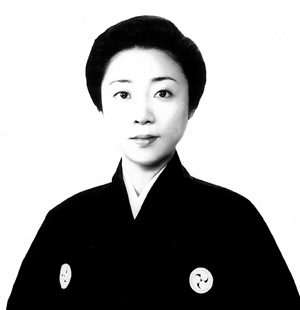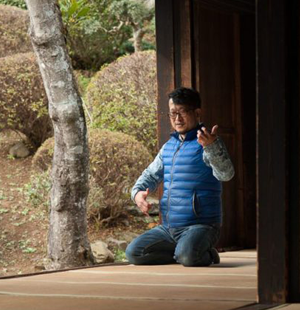Interview with Komakiyo (GidayuShamisen Player)
Please teach me how to motivate you, Gidayu Shamisen player, strongly.
I used to like Kabuki in the beginning. While I was studying at Konan University, there was a club called Kabuki Bunraku Research Department and I joined there. That is a club demonstrating Kabuki, living a life to immerse in Kabuki during my 4 years in school. During the period of being enrolled in the club, those who became national trainees of Kabuki from the seniors and the institution of the Kamigata Kabuki cram school just started to establish, and actually came in to the kabuki actor People who turned out appeared. Looking closely at the appearance of such seniors, I began to think that I would like to enter the world of Kabuki, but in order to be an actor of Kabuki there is a reality that can not be a man and I can not come by myself I understood things, I was very regretful. However, I could not give up, and as a result of looking for something that could be an active part of a woman, I found out the answer as the world of Gidayu.
How did you step into the world of justice?
In a monthly magazine of Kabuki there was a magazine called “Theater Theater”, and within that I learned that there is a “Gidayu classroom” hosted by the Gidayu Association of the general corporation. I tried participating in the experience class first, but it was more fun than I thought. In the following year, I decided to participate in the classroom at the same time as I had the chance to get a job in Tokyo. The classroom was also prepared for the way to a professional, it seemed to be a very suitable choice for my hope at the time that was aimed at becoming a professional. The one-year lesson in the classroom was a lot of fun for me. After graduating I was able to attend my master, so I decided to go into a professional activity after practicing there. For those who are interested, let me introduce a little more, “Gidayu Classroom” is a place of training for those interested in Yoshio, held for the entire year from May to the following March. Since it will be the 70th term (2017) to be held this time, it will be a classroom that lasts 70 years. I am a graduate of the 53rd period of that classroom. From the classroom, professionals are born at a rate of one in several years. If you hear that only one person is born in a couple of years, it may be felt very few, but since this classroom is not the only purpose to be professional, there are also many who are deepening their knowledge welcome. Therefore it does not mean that it is particularly small. A person who wants to do more Gidayu after graduation continues to train under the teacher in the same way as myself, and professional players are born a few years later from people in that.
Does it mean that entering the world of Gidayu will enter the same world as kabuki?
For those who are unfamiliar with this world, it may be a bit unclear. Gidayu and Kabuki are the same in the classical performing arts, but the contents are quite different. Gidayu is one of Jyoururi, one genre of classical Japanese music called Gidayu-Bushi. Gidayu – Bushi is the performance itself of the song. Even overseas, UNESCO declared in 2003 as “masterpiece on oral and human intangible heritage of human beings” and is listed in “representative list of human intangible cultural heritage list” in 2008, the word “bunraku” Although I think that I’ve heard about it, Bunraku is called Puppet Joruri and says the combination of doll movement and Gidayu’s performance. In Osaka during the Edo period, Bunrakuza, where Uemura Bunraku was performing, became famous, and Puppet Joruri came to be referred to as Bunraku.
In which point was it strongly attracted to the Gidayu Shamisen?
As I mentioned earlier, my attention at that time was Kabuki, so I searched for genres of classical Japanese music that women can play as a career after graduating from college. I started thinking about Kyogen, thought about Nagauta, Yamato-gaku that it started in the early Showa era, but I did not find it convincing. At that time I knew about Gidayu and I felt it most like kabuki. In Kabuki a lot of actors and performers gather together and play the stage, but Gidayu plays the stage with only two people, “Tayu (talk)” and “Shamisen (play)”. The place to make the stage with just two people reflected very attractive to me. Also it is one of the reasons that the heavy bass of the Gidayu Shamisen felt comfortably on the belly. Gidayu is said to be “Ongyoku noTsukasa ” and it is said to be a kinglike existence among classical Japanese music.
The shamisen is a characterful instruments that are elements of percussion instruments while being string instruments. The point I especially feel that the shamisen is superior is its expression power. “Flower bird flying moon”, that is, scenery, things, sounds in nature, movements and motions of the human mind, and so on. We will precisely calculate and play performance such as sound quality, volume, how to get “Ma”(interval), balance with Tayu’s talking. When it fits perfectly, you can experience the feeling that the world will spread out fairly. After experiencing it, I want to feel again, and it will fit deeper and deeper. What is the most attractive thing in all is that I am making a story with the sound I play. Although we mentioned earlier, in kabuki it is usual to decide the role, but in the case of Gidayu the shamisen and Tayu’s story plays all roles from beginning to end. Make the whole stage. It is also a really difficult thing, but I feel a sense of inconvenience there. In my case such a thing might be the charm of the Gidayu Shamisen.
Can you introduce some distinctive things by Gidayu Shamisen structure and how to play?
In the case of the third thread, basically it moves Bachi parallel to the torso and plays it, but when you sound like a percussion instrument, use the snap of the wrist and swing down Bachi quickly, strongly hit the skin It gives a sharp sound. Bachi of the Gidayu Shamisen is thicker and heavier than Bachi of other shamisen, so sometimes it breaks through the skin if you mistake it. However, by using the weight of Bachi, you can play various threads. Gidayu Shamisen expresses various expressions by using the space of the height from the skin to the string (the height of “H”). For that reason Koma of the Gidayu Shamisen is made very high compared to other shamisen. KOMA of the Gidayu Shamisen has other features besides height. Lead is put on the back side of Koma, and the sound slightly changes depending on the amount (weight) of lead. I use a heavy and high piece when giving a low sound, but when raising a high sound I use a piece that is lightly weighing a little lower. KOMA has a subtle change in sound depending on the craftmaker who makes it. The selection of this piece may be the most important task even in the task of deciding the sound.In addition, since the shamisen skin is a natural material, it will stretch and shrink in humidity and temperature environments. Considering the growth condition of the leather, it is also an important task to decide which KOMA you can use to produce good sound. As a structural characteristic of the Gidayu Shamisen, we also adjust the height of “Ha” by sandwiching a thin paper-like tree called Kyougi between Kakuana and Nakago-Saki, unlike other shamisen. In some cases it may be necessary to stick a sticker to Sawari and require adjustment to make Sawari ring. It is convenient for this adjustment, but Gidayu Shamisen does not use Azuma-Sawari. Bachi is also special, so it’s different from other shamisen.One example is the thumb position. Unlike other shamisen, put your thumb on top of Bachi and add it to the corner of the side. Biki of the Gidayu Shamisen is a holding way that it is hard to hold at the beginning because the little finger crawls downward (backside) rather than side. As you continue practicing, you will be able to tightly grasp the little finger tyloma. Actually this little finger is working while playing. I am working to change the sound by touching KOMA with my little finger and holding KOMA lightly. Tuning is like Tsugaru Shamisen etc with 4 HON, but today I played with 7 in my case. When playing with a woman ‘s Tayu I will tune with 1 Hon or 2 Hon. When I need a flashy sound in ensemble it is 2 Hon. When it is Male’s Tayu it will be 5 Hon 6 Hon. It depends on how low voice Tayu comes out. In many cases, such information is often unknown, it may be because the distribution volume of Gidayu Shamisen itself is small.
What kind of activities do you think is necessary for the more people to know the Gidayu Shamisen?
My personal impression, there are few people who know the Gidayu Shamisen in a general place. Conversely, many people in the Kabukiza area know Gidayu. In the Edo era, Gidayu was popular as a popular music, but today there are cognitions in a special environment, but the fact is that there are many people who do not know. Also, as a reason why the professional of the Gidayu Shamisen player has few twenties, it may also be related to the fact that the person who comes to Gidayu classroom has already started late twenties. Because it is normal for the first stage to be in their thirties. There is nobody who is doing justice since childhood. At the Gidayu Association, efforts are being made to hold a Gidayu lecture for children, and to create a place of introduction widely through workshops and so on. However, since Goryu’s story is originally intended for adults, I think that we need to think about developing content for children and making sounds accordingly. Gidayu Shamisen has a fixed set of sounds tailored to the narrative, so it is surprisingly difficult for you to make a work in a new way. One goal for me is that I would like to make young people, especially female students, recognize the choice of Gidayu’s professional musicians in Japan. For foreign countries, I think that not only the word “bunraku” but also Gidayu and even the Gidayu Shamisen would be better known. I plan to challenge myself if my child grows a little larger.

